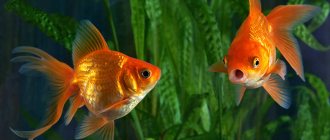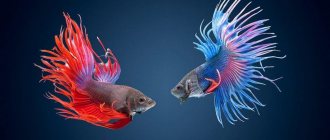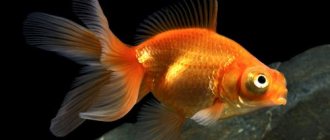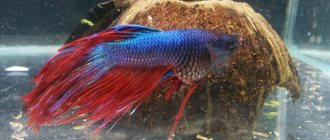- Optimal living conditions
- Symptoms of ailments
- Quarantine for illnesses
- Infectious diseases
- Other diseases
Goldfish are frequent inhabitants of aquariums, which fascinate with their beauty and at the same time calm. But when the underwater beauty begins to change her appearance for the worse, the owners are at a loss as to what happened. Yes, unfortunately, goldfish get sick, and often their owners are to blame. Improper care, failure to follow basic rules and recommendations, and skimping on equipment and feed lead to various ailments. If they are not eliminated in time, the pets die. Goldfish diseases are treatable if you act quickly, but prevention is best.
Optimal living conditions
In small tanks they die within a short period. For a flock of 4-5 individuals, you need a large aquarium with a volume of 100 liters or more; for a pair, a vessel of 40-60 liters is also suitable. The ideal water temperature is 25 degrees, pH – 7. In case of hypothermia, the fish go to the bottom, lose their appetite, become lethargic, and when overheated, they swim up and swallow air, fussily moving in different directions. Be sure to install a powerful filter with aeration, or better yet, with a compressor. Goldfish need a lot of oxygen and clean water, which they heavily pollute with excrement. Don’t go overboard with the decor, the main thing is space, the fish don’t need to hide in grottoes and shells, they get injured there. Make sure there are living plants in the aquarium that regulate the biobalance and provide the fish with vitamins. You should not give only dry food, plant food is also needed - lettuce, spinach, fruit. Feeding occurs twice a day at the same time. Goldfish water is changed more often than other inhabitants of home aquariums - once a week. Follow the recommendations to avoid diseases of the goldfish in the aquarium.
The body turned white
Unnatural paleness coupled with unusual behavior can be caused by insufficiently nutritious food, improper maintenance or disease:
- Ichthyophthiriasis (see above).
- "Cotton disease." Characterized by the appearance of growths or plaque on the body that look like cotton wool, restless behavior, and itching. Help: normalizing water parameters, eliminating sources of stress, products containing phenoxyethanol.
- Costiosis. Other signs: itching, white or gray coating, restlessness. For 7 days, place the fish daily for 15 minutes in a saline solution of 25 g per 10 liters.
Symptoms of ailments
If the disease of the goldfish in the aquarium cannot be avoided, timely treatment must be provided. Symptoms that should cause concern:
- enlarged or clouded eyes;
- erratic movements;
- lack of appetite;
- bloated body;
- spots of any color and size;
- red gills;
- white mucus and plaque;
- belly up flips;
- growths;
- peeling of skin.
Before purchasing an aquarium, study photos and descriptions of goldfish diseases so that you can act quickly and correctly at the first symptoms.
Falling off of scales
Golden carp scales may fall off for the following reasons:
- Excess nitrites. We need to change the water and add conditioners.
- The neighbors are catfish. They damage the scales. You can increase the proportion of plant food, but it is safer to remove the sticky ones.
- Ichthyosporiliosis. It is also recognized by convulsions, bulging eyes, bruising, heavy breathing, intermittent swimming and lying on the bottom on its side. It is difficult to treat.
- Lepidorthosis. The scales rise and fall out in certain areas of the body.
- Tuberculosis.
Quarantine for illnesses
If you bought an aquarium, take care of a spare tank with a volume of 40-50 liters with mandatory aeration. You need to move a sick fish into it, even if it is not infectious, but simply injured. It costs very little to feed. Antibacterial and vitamin preparations (potassium permanganate solution, tea tree oil, special Sera Fishtamin vitamins) are added to the isolation tank. Quarantine lasts up to 2 weeks. If the fish takes on its usual color, swims calmly, its scales shimmer, and there is no damage, rot or mucus, you can return the pet “home.”
Red spots
The following diseases can cause them:
- Rubella. This is a common name for a group of diseases with similar symptoms: spring viremia of carp, aeromonosis, pseudomonosis, vibriosis. Characterized by hemorrhages, especially in the head area, ulcers, bulging eyes, and swollen abdomen.
- Gill and skin flukes. Restless behavior, the desire to constantly itch, pressed fins, the appearance of slugs on the skin. Antiparasitic treatment is required.
- Ammonia poisoning.
Infectious diseases
The most common diseases of goldfish include:
- Ichthyophthyriosis. This is a fungus that, when infected, covers the fish with small white dots, similar to grains of semolina. There is a gradual destruction of fins and scales. If the process is not stopped, the fish will die. At the initial stage, you can try to treat your pet with salt baths; if that doesn’t help, use Bicillin.
- Branchiomycosis. Another type of fungus that quickly destroys the body of fish. It all starts with blockage of blood vessels, as evidenced by red stripes, then the gills rot, which can be seen by gray erosions on the body. The cause of the disease is live food or infection from other individuals. You will need immediate isolation from the aquarium, complete cleaning and disinfection. Among the medications, methylene blue, furazolidone, and magnesium sulfate help well.
- Lepidorthosis. This bacterial disease is easily recognized by its raised scales. Untimely treatment leads to complete loss of scales and death of the individual.
- Fin rot. A dangerous disease that contributes to the destruction of the tail, fins, and then the entire body of beauties. The first signs are a white coating on the head, cross-section of the edges of the tail, and a bluish tint to the fins. Fin rot can only be treated in its early stages. The fish are regularly bathed in a solution of methylene blue, malachite green, and salt. Antibiotics can be used.
Please note! If you want to breed goldfish, try to avoid antibiotics. Their use, along with strong chemicals, leads to infertility.
- Rubella. It can be viral and bacterial. Treatment of bruises in the same way as other infectious diseases: with salt, potassium permanganate, blue solution. But antibiotics can not just be poured into the tank, but given with food. Treatment of rubella in goldfish is delayed for a month.
Aquarium first aid kit
In the past, aquarists were forced to treat aquarium fish with human medications, but those days are long gone. In pet stores specializing in aquariums, you can find many modern drugs designed to treat fish. Their action is milder and there are much fewer side effects.
It is advisable to have these tools on hand:
- Antipar. This medication includes a mixture of malachite green, methylene blue and formaldehyde. Used to treat fungal, bacterial diseases, as well as bacteria caused by ciliates, such as ichthyophthyriosis.
- SERA Baktopur. The drug is effective in the treatment of bacterial diseases and has an antiseptic effect.
- SERA Mycopur. An antifungal agent, it is recommended to use it together with Baktopur, since bacterial diseases are accompanied by fungal ones, and vice versa.
- SERA T. Water conditioner that helps purify water from ammonia. This is especially important when using antibacterial agents and antibiotics.
These are some of the most commonly found products in pet stores. There are also analogues from Tetra, JBL and NILPA, the composition of which is basically identical.
Pet illness is an unpleasant event that can happen to anyone. Do not hesitate to seek help from specialists and do not give up if you fail. Treat such phenomena as experience that will allow you to avoid mistakes in the future.
Other diseases
Aquarists also have to deal with less dangerous diseases of goldfish, which are caused by improper care. Among them:
- Argulez. In simple words, these are parasites that attach themselves to goldfish and feed on their blood. This causes toxicity, reddened areas, swelling, inflammation and ulcers. It is better to get rid of lice mechanically. Place the specimen on a damp cotton swab and remove the parasites with tweezers. It is better to leave the aquarium dry for a couple of weeks so that the rest of the argulus die. Drugs such as sera Argulol and ordinary potassium permanganate also help. Considering that lice love warmth, they appear in the summer. Therefore, at this time you should not get new individuals, buy live food, plants, or soil. And the aquarium should be disinfected once again.
Carefully! These fish parasites even “attack” people in natural bodies of water. They stick to the eyes when a person swims underwater without a mask.
- Changeling. Goldfish love to eat and do not know when to stop, which leads to overeating and swim bladder disease. The individual swells, turns over and practically does not move. Treatment of changeling in goldfish is limited to quarantine in an isolation room with a low water level and increased aeration, diet. First, a hunger strike is carried out for a couple of days, then only vegetable food is given in minimal quantities.
- Asphyxia. The gills of pets are constantly slightly open, they do not grow, they do not eat well, they are on the surface of the water - which means the reason is poor aeration, incorrect temperature or overcrowding of the tank. Eliminating the causes and cleaning the walls of the vessel from organic waste will relieve the disease.
- Gas embolism. Appears due to excess oxygen or improper water changes. The symptoms seem scary: blisters on the body, swelling, darkening of the gills. But everything goes away after the individuals are transferred to an aquarium with normal parameters.
Not everyone is cut out to be a goldfish rescuer. You need experience, knowledge, time, additional resources. Qualified employees will do everything ourselves. They know how to choose a medicine for goldfish and recognize all the symptoms. Just call, voice the problem, and treatment will begin at lightning speed. You should not delay seeking qualified help; there are infections that progress very quickly. A few hours can save your pet's life. Don't panic, in such situations you can make many irreversible mistakes that will aggravate the situation. Specialists should treat goldfish, and your mission is to admire them and maintain optimal living conditions.
The fish swims belly up (changeover)
Possible causes of swim bladder dysfunction:
- Binge eating. In this case, the fish needs to fast for 3 days, and then feed it with green peas without skin for some time.
- Unbalanced diet, excess protein foods. Solution to the problem: stick to a diet in which 20-30% is live and frozen food, the rest is plant food.
- Dropsy. Check the environmental parameters for the amount of nitrites and adjust them to normal if necessary.
- Mycobacteriosis (tuberculosis). Other manifestations: bulging eyes, swollen abdomen, curvature of the spine, dull color, desire to hide. Place the fish. Check the medium for nitrites and ammonia.
Treatment of fin rot in cockerels
If a betta becomes ill, you should not immediately resort to using medications, but rather disinfect the aquarium.
The disease is treated quite effectively. There are a huge number of drugs that give a guaranteed result, and the fish recovers quickly. The main thing is to recognize the onset of the disease in a timely manner.
If fin rot occurs in a cockerel, you should not immediately resort to the use of medications. It is necessary to disinfect the soil, plants and accessories, replace a third of the water and raise the temperature to the maximum that the inhabitants can withstand. The aquarium is kept in such conditions for several days. If the disease does not recede, then the situation is somewhat more complicated. The use of special equipment will provide effective and quick results. They can be used in a community aquarium without removing infected pets. The aquarist adds the drug according to the instructions for five days. As a rule, this time is enough for the fin rot of the betta to be eliminated. In particularly difficult cases, treatment lasts up to ten days.
Treatment of fin rot in platies video:
Fin rot in guppies, treatment with Antipar video:
Cold
The common belief that goldfish are not susceptible to colds is not true. A sharp change in the temperature of the aquatic environment leads to irritation of nerve endings and, as a result, to functional disorders. Outwardly, it looks like dead skin and its subsequent peeling.
Correct prevention of colds in fish helps to avoid such situations, namely: maintaining a constant temperature, adding methylene blue to the water, intensive aeration of the water, switching to a variety of animal feeds, and introducing pre-washed earthworms into the diet. Any freshly frozen food, be it daphnia, bloodworms, etc., should be warmed to room temperature before giving it to the fish.
Dermatomycosis, or saprolegnia
The causative agent of the disease is Saprolegnia fungi. The disease manifests itself against the background of a decrease in the general immunity of the fish, which occurs as a result of another illness, injury or improper care. If you notice that the fins and gills of the fish are covered with thin white threads, it is quite possible that this is dermatomycosis. If measures are not taken in time, fungal spores will grow into internal organs and muscles, the fish will stop active activity and lie on the bottom.
As a treatment, you can use salt baths and lotions from a 0.1% solution of potassium permanganate, 0.05% solution of trypaflavin. It is better not to use lapis solution, because not all fish tolerate it well.
The rules for using medicinal solutions are as follows: before each procedure they are prepared anew: you cannot use today the one that was prepared yesterday. Care must be taken to ensure that the solution does not get on the gills! By the way, medicinal lotions are effective not only for treating fish affected by ringworm, but also those affected by argulus and leeches.











